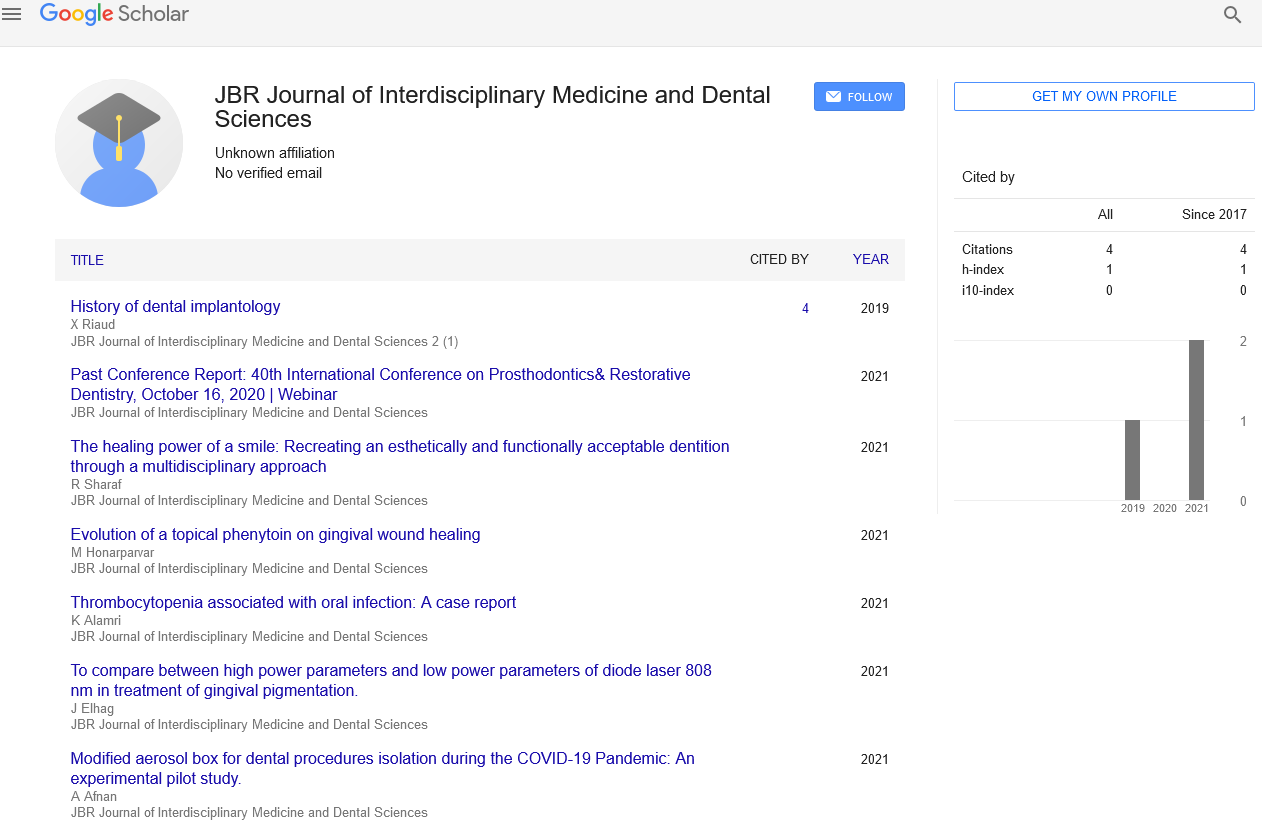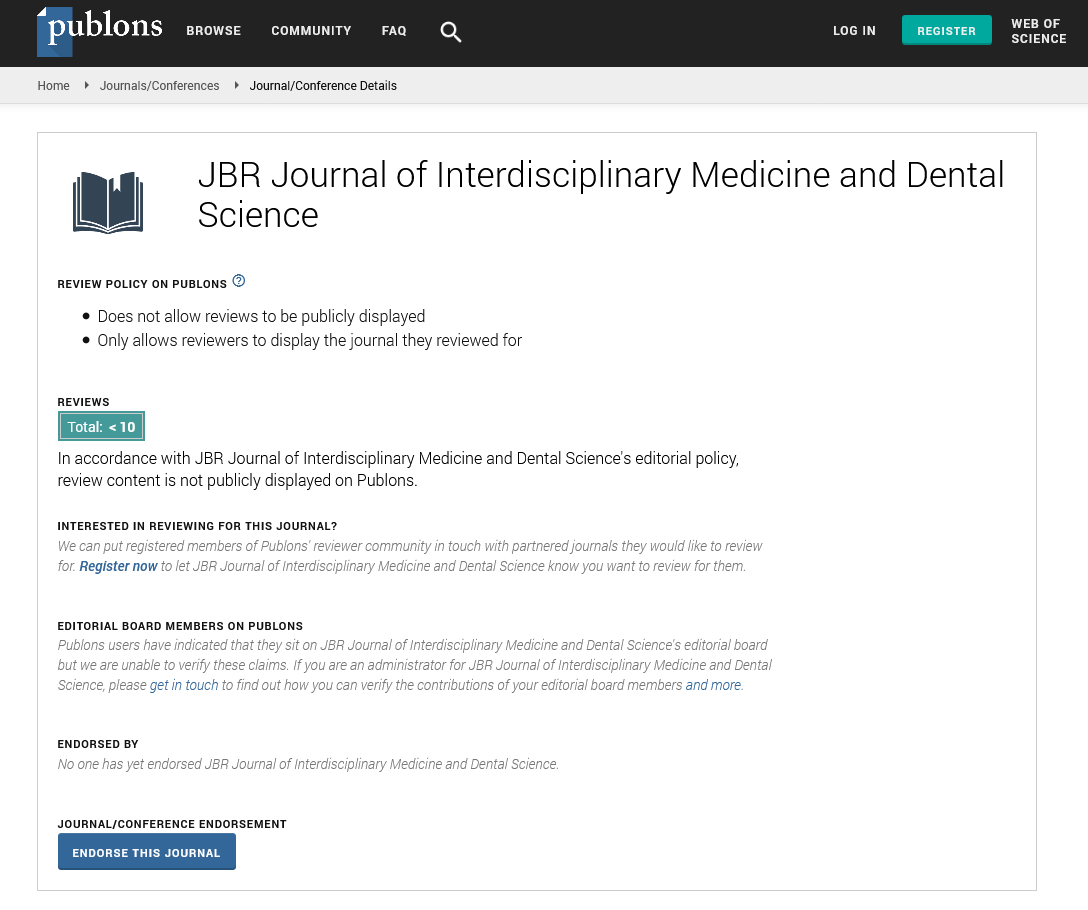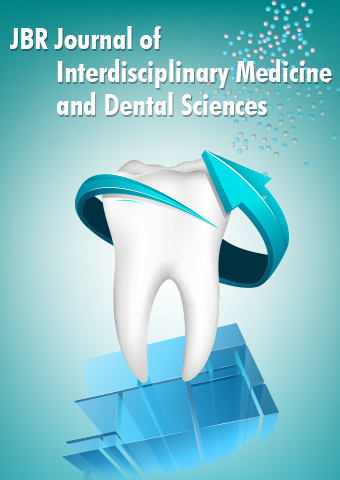Editorial - JBR Journal of Interdisciplinary Medicine and Dental Sciences (2023) Volume 6, Issue 3
Prosthodontics Restoring Smiles and Improving Quality of Life
Irfan Kelly*
Department of pharmacology, India
Department of pharmacology, India
E-mail: kly_irfan@gmail.com
Received: 01-May-2023, Manuscript No. jimds-23-100152; Editor assigned: 04-May-2023, PreQC No. jimds-23-100152 (PQ); Reviewed: 19-May-2023, QC No. jimds-23-100152; Revised: 24-May-2023, Manuscript No. jimds-23-100152 (R); Published: 31-May-2023, DOI: 10.37532/2376- 032X.2023.6(3).52-54
Abstract
Prosthodontics, a specialized branch of dentistry, focuses on restoring and replacing missing teeth and associated oral structures. This article provides an overview of prosthodontics, highlighting the various prosthetic solutions available to patients. Dentures, dental implants, crowns, bridges, and veneers are discussed as common treatment options. The article emphasizes the benefits of prosthodontics treatment, such as improved oral function, enhanced aesthetics, better oral health, longevity of prosthetic devices, and personalized care. The abstract concludes by encouraging individuals with dental challenges to consult with a prosthodontics for customized treatment and the restoration of their smiles.
Keywords
Prosthodontics • Dental prosthetics • Dental implants • Dental implants • Dentures
Introduction
Prosthodontics, a specialized field within dentistry, focuses on the restoration and replacement of missing teeth and associated oral structures. It plays a crucial role in restoring smiles and enhancing the quality of life for individuals who have experienced tooth loss, facial defects, or compromised oral function [1]. By utilizing various prosthetic devices and treatments, prosthodontics are able to rehabilitate patients, improving both their oral health and overall well-being. The impact of tooth loss or oral dysfunction extends beyond the physical aspect, affecting individuals emotionally and socially [2]. Missing teeth can lead to difficulties in chewing and speaking, which can significantly impact a person’s confidence and self-esteem. Additionally, oral health problems resulting from tooth loss can have a cascading effect on overall health, affecting nutrition and general well-being. Prosthodontics offers a range of solutions tailored to address each patient’s unique needs. Dentures, dental implants, crowns, bridges, and veneers are some of the commonly used prosthetic devices that prosthodontics employ to restore functionality, aesthetics, and oral health. These treatments are designed to closely resemble natural teeth in terms of appearance, function, and durability, allowing patients to regain their ability to bite, chew, speak, and smile with confidence [3]. The benefits of prosthodontics treatment go beyond mere aesthetics. By replacing missing teeth and restoring oral function, patients can experience improvements in their overall quality of life. They can enjoy a varied diet, communicate effectively, and participate in social activities without self-consciousness [4]. Moreover, prosthodontics interventions help maintain the integrity of the jawbone and prevent adjacent teeth from shifting, thus promoting long-term oral health. One of the key advantages of prosthodontics is the personalized and customized nature of treatment. Prosthodontics carefully evaluate each patient’s unique dental condition, facial structure, and personal preferences to develop an individualized treatment plan. This ensures that the prosthetic devices not only fit comfortably but also blend seamlessly with the natural dentition, resulting in a natural-looking smile.
Discussion
Prosthodontics, also known as dental prosthetics or prosthetic dentistry, is a specialized branch of dentistry that focuses on the restoration and replacement of missing teeth and associated oral structures. It aims to rehabilitate patients who have suffered tooth loss, facial defects, or compromised oral function, thereby improving their oral health and quality of life. Prosthodontics are highly trained dental professionals who possess the knowledge, skills, and expertise to design, construct, and fit dental prostheses to meet each patient’s unique needs.
Types of prosthetic solutions
Prosthodontics encompasses a wide range of prosthetic solutions, each tailored to address specific dental conditions and patient requirements. The following are some of the commonly used prosthetic devices and treatments in prosthodontics:
Dentures: Dentures are removable prosthetic devices that replace missing teeth and surrounding tissues. They can be partial or complete, depending on the number of teeth missing. Dentures restore the ability to chew and speak properly, while also improving the appearance of the smile [5].
Dental implants: Dental implants are titanium posts that are surgically inserted into the jawbone to serve as artificial tooth roots. They provide a strong foundation for the attachment of prosthetic teeth, such as crowns, bridges, or dentures. Dental implants offer excellent stability, functionality, and aesthetics, closely resembling natural teeth.
Crowns: Dental crowns, also known as caps, are custom-made restorations that cover the entire visible portion of a damaged tooth. They restore the tooth’s shape, size, strength, and appearance while protecting it from further damage [6].
Bridges: Dental bridges are used to replace one or more missing teeth by anchoring artificial teeth (pontics) to adjacent natural teeth or dental implants [7]. They restore the appearance and function of the smile, preventing adjacent teeth from shifting out of position.
Veneers: Dental veneers are thin, tooth-colour shells made of porcelain or composite resin. They are bonded to the front surface of the teeth to enhance their appearance, correcting issues like discoloration, chipping, or misalignment [8].
Benefits of prosthodontics treatment
Prosthodontics treatment offers numerous benefits, both in terms of oral health and overall well-being. Here are some key advantages:
Restored function: Prosthetic devices enable patients to regain the ability to chew, bite, and speak properly, improving their overall oral function and nutritional intake. Enhanced Aesthetics: prosthodontics solutions significantly improve the appearance of the smile, boosting self-confidence and self-esteem. Patients can enjoy a natural-looking smile that seamlessly blends with their existing teeth. Improved Oral Health: Replacing missing teeth with prosthetic devices helps maintain the integrity of the surrounding oral structures, such as the jawbone and adjacent teeth [9]. This contributes to better oral health and reduces the risk of oral diseases and complications. Longevity and Durability: Prosthetic restorations, when properly cared for, can last for many years, providing long-term benefits and value for patients. Customized Treatment: Prosthodontics treatment is highly personalized, with each prosthetic device crafted to fit the individual patient’s needs, preferences, and facial structure. This ensures optimal comfort and functionality [10].
Conclusion
Prosthodontics, as a specialized branch of dentistry, holds significant importance in restoring smiles and improving the quality of life for individuals with missing teeth or compromised oral function. Through the use of various prosthetic solutions such as dentures, dental implants, crowns, bridges, and veneers, prosthodontics can effectively address the functional and aesthetic concerns of their patients. The impact of tooth loss or oral dysfunction extends beyond the physical aspect, affecting individuals emotionally and socially. By restoring oral function and enhancing the appearance of the smile, prosthodontics helps individuals regain their confidence and self-esteem. The ability to chew, speak, and smile without hesitation or embarrassment significantly improves their overall wellbeing. Moreover, prosthodontics treatment offers long-term benefits by maintaining the integrity of the surrounding oral structures, preventing further oral health complications, and promoting overall oral health. Patients can enjoy improved nutrition, better oral hygiene, and reduced risks of dental diseases. One of the remarkable aspects of prosthodontics is the personalized and customized approach to treatment. Prosthodontics carefully evaluates each patient’s unique needs, preferences, and facial structure to create prosthetic devices that fit comfortably and seamlessly with the natural dentition. This individualized care ensures optimal comfort, functionality, and natural aesthetics. Prosthodontics serves as a vital discipline in dentistry, providing solutions that restore smiles and enhance the quality of life for individuals with missing teeth or compromised oral function. By restoring oral function, improving aesthetics, and promoting oral health, prosthodontics interventions bring about positive transformations in patients’ lives. If you are facing dental challenges, consulting with a prosthodontics can pave the way for a personalized treatment plan, leading to the restoration of your smile and a significant improvement in your overall well-being.
References
- Sarikaya I, Güler AU. Effects of different surface treatments on the color stability of various dental porcelains. Journal of Dental Sciences. 6, 65-71 (2011).
- Motro PF, Karagoz PK, Kazazoglu E. Effects of different surface treatments on stainability of ceramics. The Journal of prosthetic dentistry.108, 231-237 (2012).
- Sarıkaya I, Yerliyurt K, Hayran Y. Effect of surface finishing on the colour stability and translucency of dental ceramics. BMC Oral Healt.18, 1-8 (2018).
- Meral K, Bilge TB. Effects of accelerated artificial aging on the translucency and color stability of monolithic ceramics with different surface treatments. The Journal of prosthetic dentistr.121, 712-e1 (2019).
- Atay A, Karayazgan B, OzkanY et al. Effect of colored beverages on the color stability of feldspathic porcelain subjected to various surface treatments. Quintessence International.40 (2009).
- Kanat‐Ertürk, Burcu. Color stability of CAD/CAM ceramics prepared with different surface finishing procedures. Journal of Prosthodontics.29, 166-172 (2020).
- Derafshi R, Khorshidi H, Kalantari M et al. The effect of chlorhexidine mouth rinse on the colour stability of porcelain with three different surface treatments: An in vitro study. Journal of Dental Biomaterials.1, 3-8 (2014).
- Köroğlu A, Sahin O, Dede DO et al. Effect of different surface treatment methods on the surface roughness and color stability of interim prosthodontic materials. The Journal of prosthetic dentistr.115, 447-455 (2016).
- Atay A, Oruç S, Ozen J et al. Effect of accelerated aging on the color stability of feldspathic ceramic treated with various surface treatments. Quintessence International.39 (2008).
- Alp, Gulce. Effect of surface treatments and coffee thermocycling on the color and translucency of CAD-CAM monolithic glass-ceramic. The Journal of prosthetic dentistry120, 263-268 (2018).
Indexed at, Google Scholar, Crossref
Indexed at, Google Scholar, Crossref
Indexed at, Google Scholar, Crossref
Indexed at, Google Scholar, Crossref
Indexed at, Google Scholar, Crossref
Indexed at, Google Scholar, Crossref
Indexed at, Google Scholar, Crossref


